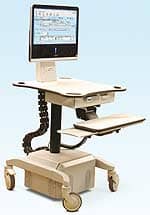The use of breast shields is the technique of choice to protect the breasts of women from radiation exposure while undergoing chest CT examinations, according to a new study presented during the American Roentgen Ray Society Annual Meeting on May 4 in Chicago. The International Commission of Radiation Protection (ICRP) increased the tissue weighting factor for the breast from 0.05 to 0.1 noting that breast tissue is even more sensitive to radiation exposure than previously thought.
For perspective, the delivery of 1 rad to a 35-year-old woman is estimated to increase her lifetime risk of breast cancer by 13.6%; each CT exam delivers at least twice that amount, said Rafel Tappouni, MD, the lead author of the study.
Tappouni and his colleagues at Penn State Hershey Medical Center in Hershey, Pa, measured the radiation dose to the front and back of a breast phantom (an object that mimics the size of the breast area of a person) using a breast shield and using a new technique called posteriorly centered partial CT, in which the CT scanner turns on and off as it scans the patient.
“We found that posteriorly centered partial CT does decrease skin entrance radiation dose to the breast by 16%, but increases overall radiation dose to the chest by 8%,” said Tappouni. “The bismuth breast shields, on the other hand, reduced skin entrance dose to the breast by 38% without an increase in overall radiation dose,” he said.



